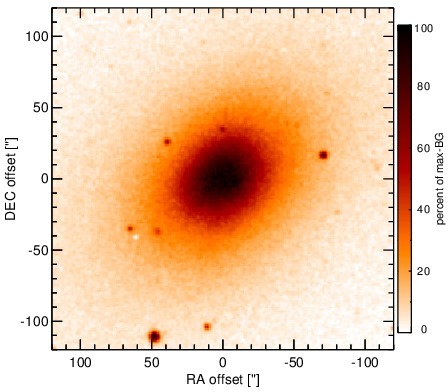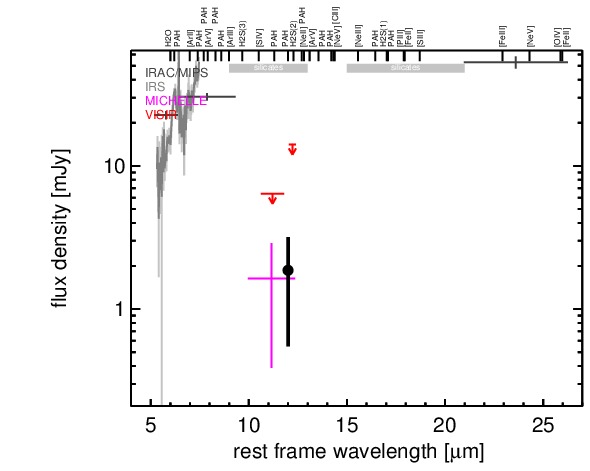Sasmirala Individual Information for NGC 5363
Description
NGC 5363 is a dusty peculiar early-type galaxy at a redshift of z = 0.0038 (D ~ 21.0 Mpc) with a LINER nucleus [ho_search_1997-1]. The presence of an AGN is supported by the X-ray properties [gonzalez-martin_x-ray_2009]. Furthermore, a compact radio core with biconical elongated emission along a PA~ 145∘ was detected on arcsecond-scales [hummel_central_1984], and jet-like elongation can be seen on milliarcsecond-scale along a PA~-100∘ [nagar_radio_2005]. NGC 5363 was observed with ISO [xilouris_dust_2004, temi_cold_2004] and Spitzer/IRAC, IRS and MIPS. It appears as an extended nucleus (diameter~ 15arcsec ~ 1.5 kpc; PA~ 35∘) embedded within larger-scale host emission (see also [pahre_mid-infrared_2004, pahre_spatial_2004]). In addition, a bright compact source ~ 6.4arcsec ~ 650 pc to the west of the nucleus is visible (PA~-108∘). The IRS LR mapping-mode PBCD spectrum consists of the shortest wavelength setting only. It indicates the presence of the PAH 6.2 μm feature as typical for star formation (see also [mason_nuclear_2012]). The nuclear region of NGC 5363 was observed with Michelle in the N’ filter in 2008 [mason_nuclear_2012], and with VISIR in two N-band filters in 2009 [asmus_mid-infrared_2011]. A compact nucleus is only detected in the Michelle image with a low S/N. The nucleus is embedded within very weak bar-like emission extending several arcsecond along a PA~ 45∘. In addition, the compact source visible in the IRAC images is also weakly detected. To our knowledge, this compact source has not been reported so far at any wavelength apart from its detection in the 2MASS point-source catalogue. Because it is also visible in the SDSS images and appears very blue, it is presumably a foreground star. We perform manual PSF-scaling to measure the unresolved flux of the nucleus, which provides a value consistent with [mason_nuclear_2012] and much lower than the Spitzer spectrophotometry. The two derived flux upper limits from the VISIR images are consistent with the N’ flux.
- [asmus_mid-infrared_2011] D. Asmus, P. Gandhi, A. Smette, S. F. Hönig, and W. J. Duschl. Mid-infrared properties of nearby low-luminosity AGN at high angular resolution . A&A , 536 pp. 36, December 2011.
- [gonzalez-martin_x-ray_2009] O. González-Martín, J. Masegosa, I. Márquez, M. Guainazzi, and E. Jiménez-Bailón. An x-ray view of 82 LINERs with chandra and XMM-Newton data . A&A , 506 pp. 1107–1121, November 2009.
- [ho_search_1997-1] Luis C. Ho, Alexei V. Filippenko, and Wallace L. W. Sargent. A search for ``Dwarf'' seyfert nuclei. III. spectroscopic parameters and properties of the host galaxies . ApJS , 112 pp. 315, October 1997.
- [hummel_central_1984] E. Hummel, J. M. van der Hulst, and J. M. Dickey. Central radio sources in spiral galaxies: Starburst or accretion . A&A , 134 pp. 207–221, May 1984.
- [mason_nuclear_2012] R. E. Mason, E. Lopez-Rodriguez, C. Packham, A. Alonso-Herrero, N. A. Levenson, J. Radomski, C. Ramos Almeida, L. Colina, M. Elitzur, I. Aretxaga, P. F. Roche, and N. Oi. The nuclear infrared emission of low-luminosity active galactic nuclei. AJ , 144 pp. 11, July 2012.
- [nagar_radio_2005] N. M. Nagar, H. Falcke, and A. S. Wilson. Radio sources in low-luminosity active galactic nuclei. IV. radio luminosity function, importance of jet power, and radio properties of the complete palomar sample . A&A , 435 pp. 521–543, May 2005.
- [pahre_mid-infrared_2004] Michael A. Pahre, M. L. N. Ashby, G. G. Fazio, and S. P. Willner. Mid-infrared galaxy morphology along the hubble sequence . ApJS , 154 pp. 235–241, September 2004.
- [pahre_spatial_2004] Michael A. Pahre, M. L. N. Ashby, G. G. Fazio, and S. P. Willner. Spatial distribution of warm dust in early-type galaxies . ApJS , 154 pp. 229–234, September 2004.
- [temi_cold_2004] Pasquale Temi, Fabrizio Brighenti, William G. Mathews, and Jesse D. Bregman. Cold dust in early-type galaxies. i. observations . ApJS , 151 pp. 237–269, April 2004.
- [xilouris_dust_2004] E. M. Xilouris, S. C. Madden, F. Galliano, L. Vigroux, and M. Sauvage. Dust emission in early-type galaxies: The mid-infrared view . A&A , 416 pp. 41–55, March 2004.
Images

Optical image (DSS, red filter). Displayed are the central 4 arcmin with North being up and East to the left. The colour scaling is linear with white corresponding to the median background (BG) and black to the 0.01% pixels with the highest intensity.

Spitzer MIR images. Displayed are the inner 40 arcsec with North being up and East to the left. The colour scaling is logarithmic with white corresponding to median BG and black to the 0.1% pixels with the highest intensity. The label in the bottom left states instrument and central wavelength of the filter in micron (I: IRAC, M: MIPS).

Subarcsecond-resolution MIR images sorted by increasing filter central wavelength. Displayed are the inner 4 arcsec with North being up and East to the left. The colour scaling is logarithmic with white corresponding to median BG and black to the 75% of the highest intensity of all images in units of sig_bg. The inset image (where present; either bottom or top right) shows the central arcsecond of the PSF from the calibrator star, scaled to match the science target. The labels in the bottom left state instrument and filter names (C: COMICS, M: Michelle, T: T-ReCS, V: VISIR).
SEDs


MIR SED. The description of the symbols in all the SED plots (where present) is the following: Grey crosses and solid lines mark the Spitzer/IRAC, MIPS and IRS data. The colour coding of the other symbols is as follows: green for COMICS, magenta for Michelle, blue for T-ReCS and red for VISIR data. Darker-coloured solid lines mark spectra of the corresponding instrument. The black filled circles mark the nuclear 12 and 18 micron continuum emission estimate from the data (where present). The ticks on the top axis mark positions of common MIR emission lines, while the light grey horizontal bars mark wavelength ranges affected by the silicate 10 and 18 micron features.